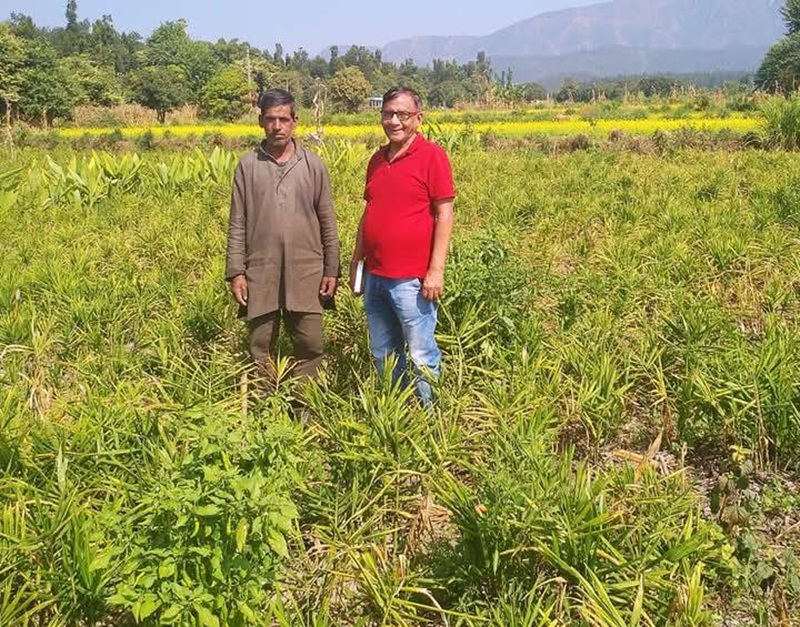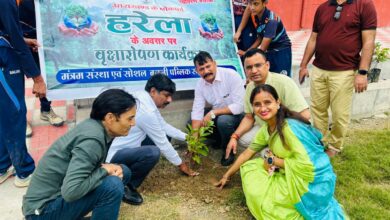
Dr. Rajendra Kuksal
(Senior Agriculture and Horticulture Expert)
In the hilly rainfed regions of the state, ginger cultivation is popular as a cash and commercial crop. This article provides information on suitable climate, soil, sowing methods, pest-disease management, and yield for successful ginger farming.
Climate Suitable for Ginger Cultivation
Ginger requires a warm and humid climate. Regions up to 1500 meters above sea level with temperatures ranging from 25 to 30°C are ideal. Areas with light shade, such as intercropping in orchards, help in healthier growth and better yields.
Key Points:
-
Warm and humid climate
-
Altitude up to 1500 meters
-
Temperature: 25–30°C
Soil Suitable for Ginger Cultivation
For successful ginger farming, well-drained, organic-rich sandy loam or medium loam soil is best.
-
Soil pH: 5.0 to 6.5
-
Organic carbon: More than 1%
-
If organic carbon is low, mix 10 kg per nali of forest topsoil and compost.
-
Avoid highly acidic or alkaline soils.
-
For acidic soils (pH below 6.5), add 100g lime per square meter.
Field Preparation
-
Plow the soil 2–3 times to make it friable.
-
During the final plowing, mix 4–5 quintals of farmyard manure per nali.
-
Divide the field into small beds and prepare ridges of 2 to 2.5 meters in length.
-
Sow the ginger seed rhizomes on the ridges.
Recommended Varieties of Ginger
-
Suprabha, Himgiri, Rio de Janeiro, Maran
-
Choose traditional varieties that are disease-resistant, high-yielding, and suitable for local climate and soil.
Sowing Time and Seed Quantity
-
Best time: Mid-April to May (April is ideal)
-
Seed rate: 30–40 kg per nali
-
Seed rhizome selection: 20–30g in weight, disease-free, with 1–2 buds
Seed Treatment
Chemical Treatment:
-
Soak in solution of 2g Carbendazim, 3g Copper Oxychloride, or 2.5g Mancozeb per liter of water for 20–30 minutes.
-
Dry in shade before sowing.
Organic Treatment:
-
Moisten rhizomes slightly.
-
Treat with Trichoderma (8–10g per kg of seed).
-
Dry in shade before sowing.
Note: Soil moisture is essential at sowing time.
Soil Treatment
To prevent fungal diseases:
-
Mix 1 kg Trichoderma powder with 25 kg compost.
-
Cover with a wet sack and keep in shade for a week.
-
Mix this with the field soil in 1 acre (20 nali).
Sowing Method
-
Maintain row spacing of 30–40 cm on the ridges.
-
Keep rhizome spacing of 15–20 cm.
-
Sow at a depth of 5–8 cm.
-
Plant maize in every third row for shade.
Mulching
-
After sowing, apply a 5–7 cm thick mulch (dry leaves, grass, or straw).
-
Helps retain moisture, regulate temperature, and control weeds.
-
Apply a second mulch layer after 40 days if needed.
Fertilizer and Irrigation Management
-
Fertilizer: Apply 10 liters of Jeevamrit per nali every 20–30 days.
-
Irrigation: In rainfed areas, rely on rainfall. Provide 2–3 irrigations during dry spells.
Weed Control
-
First weeding after 1 month of sowing.
-
Perform earthing up and hoeing as needed.
Major Pests and Their Control
Pests: White Grub, Rhizome Borer
Control Measures:
-
Destroy eggs, larvae, and adults.
-
Use light traps at night.
-
Install pheromone traps.
-
Spray 5–6% cow urine solution.
-
Spray Beauveria bassiana (5g/liter water).
-
Use Neem-based pesticides (Nimbicidine, Eco Neem) at 5 ml/liter water.
-
Chemical treatment: Imidacloprid or Chlorpyrifos (1 ml/liter water) – 3 sprays at 3-day intervals.
Major Diseases and Prevention
-
Rhizome Rot (Soft Rot)
-
Cause: Pythium fungus
-
Symptoms: Yellowing and drying of plant, rhizome rot.
-
-
Yellow Disease of Ginger
-
Cause: Fusarium fungus
-
Symptoms: Yellowing and drying of leaves, plant wilting.
-
Prevention:
-
Select well-drained land.
-
Treat seed with Trichoderma.
-
Practice crop rotation.
-
Spray Trichoderma solution (5g/liter water) every 5–6 days.
-
Chemical treatment: Use Carbendazim (0.1%), Mancozeb (0.3%), or Copper Oxychloride (0.3%).
Harvesting and Yield
-
Harvest time: 8–9 months (when leaves turn yellow)
-
Yield: 1.5–2 quintals per nali
-
Use disease-free fields for seed rhizome selection.
Contact
Mobile: 9456590999




